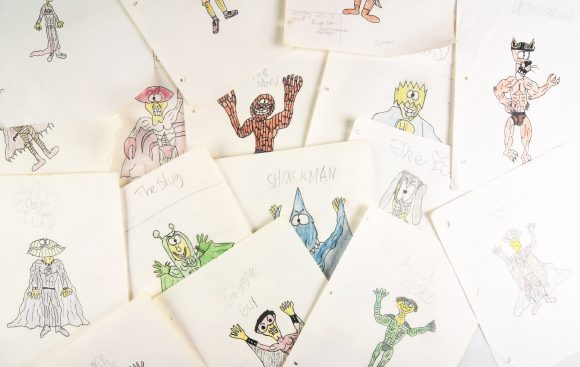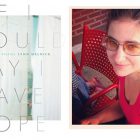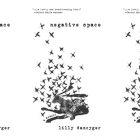Alt-weeklies, Prose Poems, Heroes: An Interview With Brandon Soderberg

Drawings by Brandon Soderberg / Photo by J.M. Giordano
2017 came, and I was in the market for words to live by. I needed a mantra to get me through the month of January. Miraculously, I found them four days into the new year: “We’re all special once we get to know each other.”
I found these words in “heroes” by Brandon Soderberg, Baltimore City Paper’s Deputy Editor and Arts Editor. The words came after a description of a Baltimore seven-year-old who was shot and killed last year: “There is a sense that Kester was somehow very special, which he was—he seemed primed to become a diplomat or something—but we’re all special once we get to know each other.”
Last year, I wrote about the uncanny resemblance between an interview Obama gave in 1995 and a passage of Marilynne Robinson’s Gilead, published in 2004. For years, I kept these words of Robinson’s close: “In every important way we are such secrets from one another, and I do believe that there is a separate language in each of us.” Just this week, in Rachel Kushner’s story “The Great Exception,” I encountered a line that reminded me of Robinson’s: “Sitting on the floor, cutting up film, they looked at each other, irises wheeling open. In between them was an infinity—the infinite distance, enacted by closeness, between two people.” Perhaps I’m hanging onto these lines—Soderberg’s especially—as we careen toward January 20. When we read, we imagine others’ lives. Surely the same is possible when it comes to policy making.
“heroes” opens with sketches Brandon made as a child and frames itself with a prose poem, where readers meet their Virgil, Brandon himself. It is Brandon the reporter, Brandon the protagonist of Section 2, who introduces us to the heroes. Readers of City Paper will have met most of them before; they come from Brandon’s reportage. They’re often protesting police brutality or giving away turkeys at the holidays. I was taken by Brandon’s ability to tease out these separate languages and by his ability to let Baltimore hear from its own. After reading, I had the opportunity to speak with Brandon about his process and the literary possibilities of editing an alt-weekly.
Patrice Hutton: Could you talk about your process as a reporter? How that translates to you bringing to life the voices and scenes you do?
Brandon Soderberg: I try and just hang out basically. I want to avoid operating like a conventional reporter in the sense that the story is whatever happens and the quotes come from an approach that’s more organic than asking for comment. Especially as a white guy, covering a deeply segregated city like Baltimore and because lot of the people I’m covering—or choose to cover—are people of color, I don’t want to intrude much or feel like too much of a gawking idiot. And so I’m kind of inhaling the atmosphere and moments and taking notes (and usually video and audio) and then I try my best to take those observations and tell a story with them. I have the luxury of being able to do that at Baltimore City Paper. And I try and just talk to people like a person not a reporter. I’ll tell them I’m a reporter obviously, but again, I’m not looking for a certain quote or angle. I just chat. I also just try and go to lots of things. It’s easier to do that when there’s less pressure to file a story at all or a certain kind of story which is the case at City Paper. But by going to lots of events such as rallies or protests or other community-oriented stuff, the people recognize you, you make connections, those last, and so on. I think when people give you their time, any time, you have a duty to try and represent them honestly and ideally, in a like 360-degree way. That doesn’t always mean “positively” either, though with this piece the goal was to focus on people tied to change, dissent, and catharsis. At the same time, I’m trying to push the definition of a “hero” or even “positivity.” I imagine some of the people included here wouldn’t be considered heroic to some readers. I’d encourage them to reconsider.
PH: Can you talk about your decision to frame the piece with a personal story? I dig the effect of it. The writer shares his vulnerability, which prepares me to take in the others’ stories from his perspective.
BS: The idea was to try and put me, the writer, on the same level as all the people I’d been writing about. As a reporter, I’m always on some level, you know, turning people’s lives including often their pain into stories. Also their joy and humor and passion and kindness, but people sharing pain or letting you see them that way is a particularly vulnerable thing and it should be respected. And as much as I want to think I’m serving their best interests or making some larger point, there’s always something at the least, a little “icky” about it. Still, my goal is to try and tell stories and make readers feel like they’re there and empathize, but the approach has its limits. So placing these reported moments (and rewriting some of them to make them feel a bit less “journalistic”) next to something from my life was a way of trying to at the least implicate myself. And better yet, try and put myself out there the way these people put themselves out there. And in a small way—don’t want to overstate it—I think the part that tells my story might help some people who might be going through similar things.
PH: Your writing covers a lot of darkness: tragedy, injustice. What is this like for you as a writer?
BS: First, something I want to add that doesn’t really fit to these questions but seems relevant. With “heroes,” I really just wanted to write something that was really sad. And sad in a way that felt real and lived-in and nuanced; hopefully not too melodramatic or indulgent—both of which are fine and important ways to approach one’s emotions, but I wanted this to be more ambient and accumulative. For about a decade, I’ve wanted to do something with those strange drawings I did as a kid but I didn’t want them to stand alone because I didn’t want it to be a thing of like, “Oh cute drawings by a kid, lol.” Also my childhood wasn’t very fun and there’s a lot of like hiding and escapism in those silly drawings. Point is, I wanted to use these for something but didn’t want it to be too light. I first decided to intercut the drawings with memories, bad ones or just messed up ones. Like drawing and opposite page a prose poem-y memory. Then I realized that was maybe too much. Then it kind of all flashed in my head. There is a monthly poetry event in Baltimore called Tender.FM, run by Janea Kelly and Anna Crooks, two great poets, and I get a lot out of going and watching them share their poems and thoughts and the other poets. One event that had Janea and Anna talking and also poets Lindsey Raspi, Evan Fuller, and Rebekah Kirkman (who is also one of my coworkers at City Paper) really moved me and had me getting introspective as I listened. I dashed down a few lines on my phone, mostly thinking about how I couldn’t conceive of expressing my feelings the way these people were all doing so in such a beautiful way. Specifically, the stuff about Gangsta Boo and Michael Corleone being heroes and the stuff about time traveling came to me right then. I’d also been ripping off Michael Kimball and Maggie Nelson in a few pieces of music criticism where basically I was just including other texts alongside my writing and stuff and that made sense as the structure for the “Mike” thing, which to me, is a poem.
So then the next thing was, “How do I not make this some indulgent sad white boi stuff?” There are enough sad white men who have done messed up stuff in their lives and lost people and well, in a way, who cares. So, I thought that by expanding the piece beyond the drawings and the Mike poem and there being this additional part that kind of went widescreen and looked at other people’s lives, it had more empathy and there was a narrative to it a bit. There’s something about it exploring different emotional states: I did the drawings when I was around 10 and so that first part reflects a childlike thing of world-building or escapism; my friend killed himself when I was like 22, so that kind of reflects being that age, early twenties, and being caught up in a lot of personal turmoil; and the last part is all reporting I’ve done over the past two years basically, so in my early thirties. I think it expresses a kind of empathy and understanding that when I was younger I liked in theory but was ill-equipped to really put into practice and the last part is me trying to put that into practice.
Writing about this stuff also has a certain sense of duty to it. Again, I don’t want to overstate or suggest that what I do has any inherent worth or helps or even matters—I’d like to think it does though—but there’s something I hope is positive about getting other people’s stories out. Often, I’m the only reporter at things. So just to write about it and therefore tell other people “so this happened” or “this person or group exists” is rewarding. Beyond that, I’m honestly writing and going out to things and experiencing things to some extent to you know, avoid the abyss of depression, capitalism, exploitation, sexism, racism, cruelty, and all that and get out of my head or pull my head out of my ass a little bit and empathize and find a few glimmers of hope. Then ideally, some of that translates to a reader somewhere. I’m amazed that “heroes” has seemingly touched some people. I’m glad people are getting something out of it.
PH: I’m interested in alt-weeklies as a space that enables innovation in reporting, especially in terms of form. Could you tell me a bit about what his space has meant for the development of your work?
BS: I think in general, alternative weeklies have been a place where you can have more “voice” in your writing. At City Paper that’s always been true. Another priority at Baltimore City Paper at least, has been storytelling and narrative, especially when I got to the paper thanks to Evan Serpick and Baynard Woods, who were the editor and managing editor in 2014 when I joined the paper. So I’m kind of building off of those ideals or alt-weekly tenets. What is also true at City Paper is that it is very collaborative and encouraging. Basically, if you’ve got an idea, you can pursue it. This is how I got into news reporting. I wanted to do it, especially post-Ferguson where it just seemed absurd to me, to continue to write political rants or arts writing with a political angle—it made more sense to get away from the desk and confront and approach these ideas directly. The staff also gave me room to learn and experiment and so, it was easy to try new things and experiment. The best writing within an institution is going to happen when a writer feels supported and has time to explore their ideas. I have that at City Paper. That has continued under the current editor Karen Houppert for sure. I kind of know she’s going to fix the weird stuff in my pieces or tell me what works and what doesn’t and that’s great. An extension of that would be a series of excellent personal essays she’s written for the paper over the past year, which feel literary and discursive and profoundly personal. Also work by Maura Callahan and Rebekah Kirkman at the paper where criticism and autobiography are mixed in a really powerful way that isn’t simply “thinkpiece”-style stuff is massively important to me feeling comfortable enough to do this. “heroes” wouldn’t have happened without those and it also wouldn’t have happened without Karen tell me this piece was good enough for the paper. It wasn’t originally written to be published in City Paper. Lastly, my approach at the paper is every week to just see what we can get away with. That doesn’t have to mean being controversial or even troll-ish only, but how we experiment with form and style and voice.



